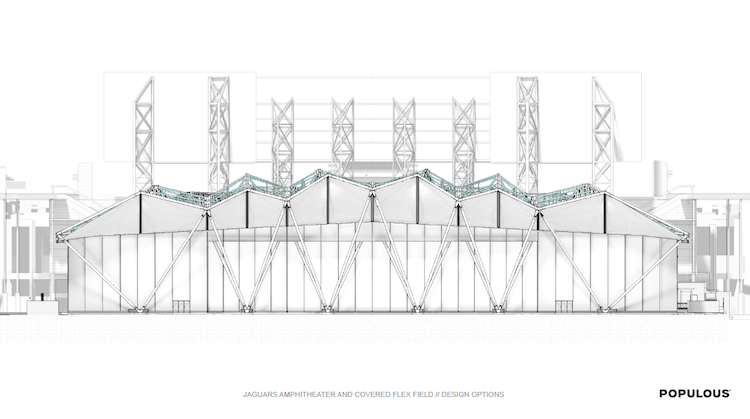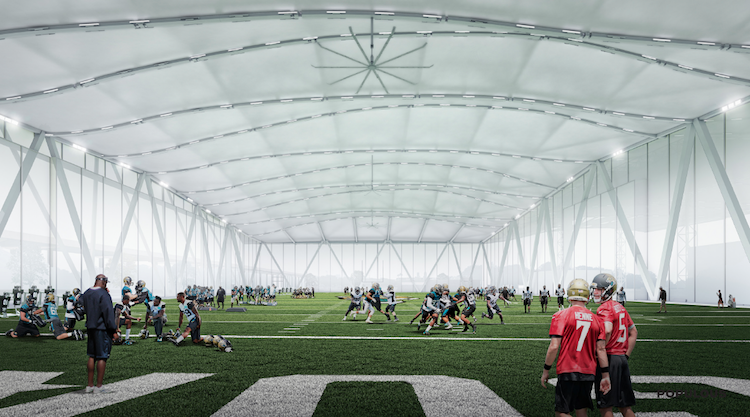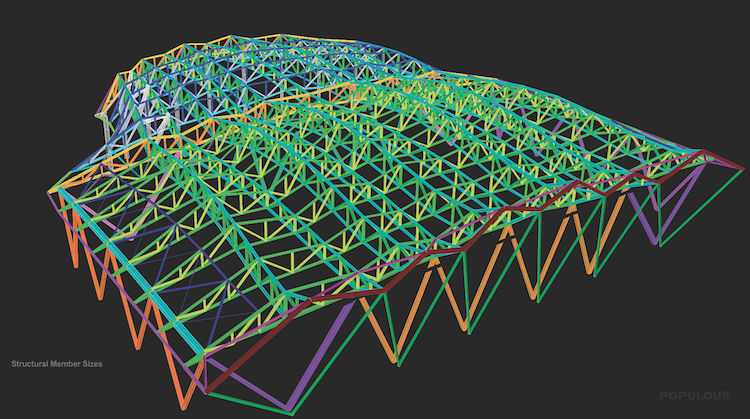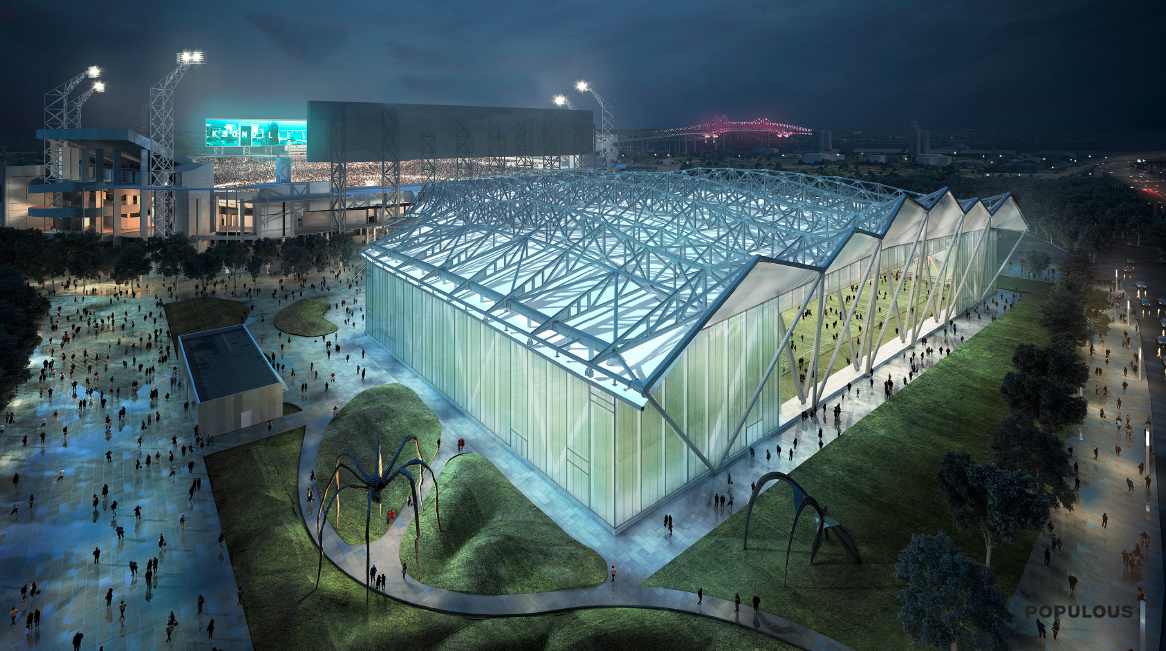Inspired by the city’s mesmerizing network of estuaries and bridges that span the St. Johns River and frame the NFL Jacksonville Jaguars’ home facility, Daily’s Place, the Jaguars’ new 6,000-seat amphitheater and 94,000-sf indoor practice field, owes its identity to a local convenience store chain that won the naming rights.
There was nothing convenient about the amphitheater’s design, however. The 160,000-sf structure is a deceptively complex building, marked by its most intricate feature, an undulating roof. Hundreds of AEC professionals scattered around the world employed a dazzling array of 3D and 4D software programs to create and build this signature design element.
The roof consists of 3,000 tons of structural steel that support a PTFE membrane. The PTFE fabric is suspended from 430-foot-long structural steel trusses that sit atop an array of structural steel v-columns. The roof links the steel beams with the PTFE membrane, which was placed on the underside of the structure—something that had never been done before.
According to Populous, this was done to keep the continuity of the building’s architecture in relation to Jacksonville’s bridges visible from the exterior. Since right angles are rare in nature and just about nonexistent when it comes to rivers, the roof—in fact, the entire structure—was designed such that it does not have a single piece of steel perpendicular to another.

Creating and implementing this riverine design was premeditated, calculated, and engineered to come together exactly the way it did. But without the use of software like Grasshopper, Rhino, and Revit, there is no way the roof could have been completed in five months, as it was.
Grasshopper was used to review the design of the structure and calculate the reductions in roof fabric that were needed to suck in the roof from the sides and reduce overhangs. Grasshopper also helped to rectify a delay in the rolled steel schedule by allowing the team to easily determine which members provided a stronger impact between rolled versus straight members.
The workflow of Rhino to Revit helped the team to discover that the roof geometry needed to be corrected at the intersection of the roof and the concourse. This workflow allowed the build team to locate the intersection early on and correct the geometry before construction advanced too far, saving time and money.
Hundreds of professionals from firms across the U.S. (Kansas City, Los Angeles, New York, and Jacksonville), England, and New Zealand participated in the project. To avoid time-wasting errors, Populous maximized its 3D model and available software to create a model that could be shared by the contractor, steel fabricator, and erector.
Populous and structural engineer and design team member Walter P Moore knew from the outset that “an embedded and nontraditional design and documentation strategy was needed to be able to deliver the complex project in the 12-month construction schedule,” says Thom Chuparkoff, AIA, LEED AP, Lead Project Manager for Populous.

Populous and Walter P Moore implemented, shared, and tested Grasshopper, Dynamo, and Revit concurrently throughout the entire project. This process allowed the design to be automated and iterative to meet the construction managers’ needs and the subcontractors’ schedules.
As the project advanced, the Grasshopper and Revit models were transferred into Tekla software, which allowed for collaboration between the design and construction teams. Populous, Walter P Moore, Hunt Construction Group, Danis Building Construction, Banker Steel, and Structurflex were able to use the same design and fabrication models concurrently to advance the design and detailing for construction.
“Walter P Moore and Populous took responsibility for the Tekla model to create the Advanced Bill of Materials model, which they turned over to Banker Steel for fabrication and assembly,” says Chuparkoff. Banker Steel was then able to use Walter P Moore to utilize their own models for the shop drawing portion. This saved time in fabrication and installation.
In the construction realm, the workflows allowed the design and construction process to become blurred. “By implementing Rhino to Revit early between the architect and structural engineer, we were able to continue that model relationship and extend the workflow into the steel fabrication and detailing,” says Chuparkoff.
Despite the sheer complexity of the structure, the RFI log amounted to less than 300 project-related questions from the field, he says. The multitude of software programs used managed to keep the project organized, updated, and distributed among all team members, regardless of where in the world they were located.
Daily’s Place held its first event May 27. Hometown band Tedeschi Trucks played the first concert in the new amphitheater, which Jaguars owner Shadhid Khan described as “iconic.”
 Grasshopper for Rhino was used with the Lunchbox plug-in to create Daily’s Place’s roof structure.
Grasshopper for Rhino was used with the Lunchbox plug-in to create Daily’s Place’s roof structure.
Software helps demystify the project’s complexity
Here’s how the software programs used in Daily’s Place helped simplify the intricate project:
Rhino and Revit were used as the primary geometry modeling programs for the project. The roof and skin were modeled in Rhino, which is considered more dynamic for complex geometry. Rhino was also the common medium for collating digital models and coordinating between teams for interfacing and clash detection of fabric and steel. It was also used for studies of ponding and drainage of the fabric surface. Revit was used for all other geometries and full construction documents.
Grasshopper for Rhino was used in tandem with the Lunchbox plug-in to build the roof surface and subdivide the structure into trusses. The roof form was designed by Populous; then the Grasshopper script was worked on jointly with Walter P Moore to create the structure for the roof.
A Grasshopper script was used to write out point data to an Excel file to transfer geometry from Rhino to Revit for coordination and documentation. Then Dynamo was used to pull that data into Revit to build native geometry with adaptive components. As Walter P Moore was engineering the structure, Populous used this workflow to represent the structure in the Revit model and drawings.
Kangaroo, a form-finding plug-in for Rhino-Grasshopper, was used in the early stages of the job to quickly study design intent. The structure could be updated as programmatic and functional directives changed the roof form. The base input for the script was 13 input curves that could be manually adjusted in Rhino.
The structural analysis components of GSA and SAP software were used in tandem to study structural steel and fabric. These programs helped analyze the structural steel framing through custom-developed plug-ins developed by Walter P Moore that used Grasshopper as the primary interface.
Tekla was used to communicate the full steel package and connection details with the steel contractor via the 3D model. This enabled the seamless transition from CDs to shop drawings and fabrication.

 Each piece of steel was modeled and placed with purpose in order to create a design that resembled Jacksonville’s numerous bridges and estuaries. The result is a building without a single piece of steel perpendicular to another.
Each piece of steel was modeled and placed with purpose in order to create a design that resembled Jacksonville’s numerous bridges and estuaries. The result is a building without a single piece of steel perpendicular to another.
Related Stories
BAS and Security | May 26, 2022
Can your intelligent building outsmart hackers?
ESD's security services studio leader Coleman Wolf offers tips, advice, and lessons for protecting real estate assets from cyberattacks.
Architects | Apr 26, 2022
Low-tech skills architects need to keep in a high-tech world
As architects continue to lean into learning and mastering the latest technologies, let us not forget the foundational, fundamental skills that are still expected by clients. RS&H National Design Director Philip Robbie explains.
AEC Tech | Apr 19, 2022
VDC maturity and the key to driving better, more predictable outcomes
While more stakeholders across the AEC value chain embrace the concept of virtual design and construction, what is driving the vastly different results that organizations achieve? The answer lies within an assessment of VDC maturity.
AEC Tech | Apr 13, 2022
Morphosis designs EV charging station for automaker Genesis
LA-based design and architecture firm Morphosis has partnered with automotive luxury brand Genesis to bring their signature brand and styling, attention-to-detail, and seamless customer experience to the design of Electric Vehicle Charging (EVC) Stations.
AEC Tech | Apr 13, 2022
A robot automates elevator installation
Schindler—which manufactures and installs elevators, escalators, and moving walkways—has created a robot called R.I.S.E. (robotic installation system for elevators) to help install lifts in high-rise buildings.
Hotel Facilities | Apr 12, 2022
A virtual hotel to open in the metaverse
A brand of affordable luxury hotels that launched in 2008, citizenM has announced it will purchase a digital land site in The Sandbox, a virtual game world owned by Animoca Brands.
Modular Building | Mar 31, 2022
Rick Murdock’s dream multifamily housing factory
Modular housing leader Rick Murdock had a vision: Why not use robotic systems to automate the production of affordable modular housing? Now that vision is a reality.
AEC Tech Innovation | Mar 9, 2022
Meet Emerge: WSP USA's new AEC tech incubator
Pooja Jain, WSP’s VP-Strategic Innovation, discusses the pilot programs her firm’s new incubator, Emerge, has initiated with four tech startup companies. Jain speaks with BD+C's John Caulfield about the four AEC tech firms to join Cohort 1 of the firm’s incubator.
AEC Tech | Feb 11, 2022
Trimble Dimensions+ 2022 Call for Speakers Now Open
Trimble has opened its Call for Speakers for the Trimble Dimensions+ 2022 User Conference, which will be held November 7-9 at the Venetian Resort in Las Vegas.
Coronavirus | Jan 20, 2022
Advances and challenges in improving indoor air quality in commercial buildings
Michael Dreidger, CEO of IAQ tech startup Airsset speaks with BD+C's John Caulfield about how building owners and property managers can improve their buildings' air quality.














